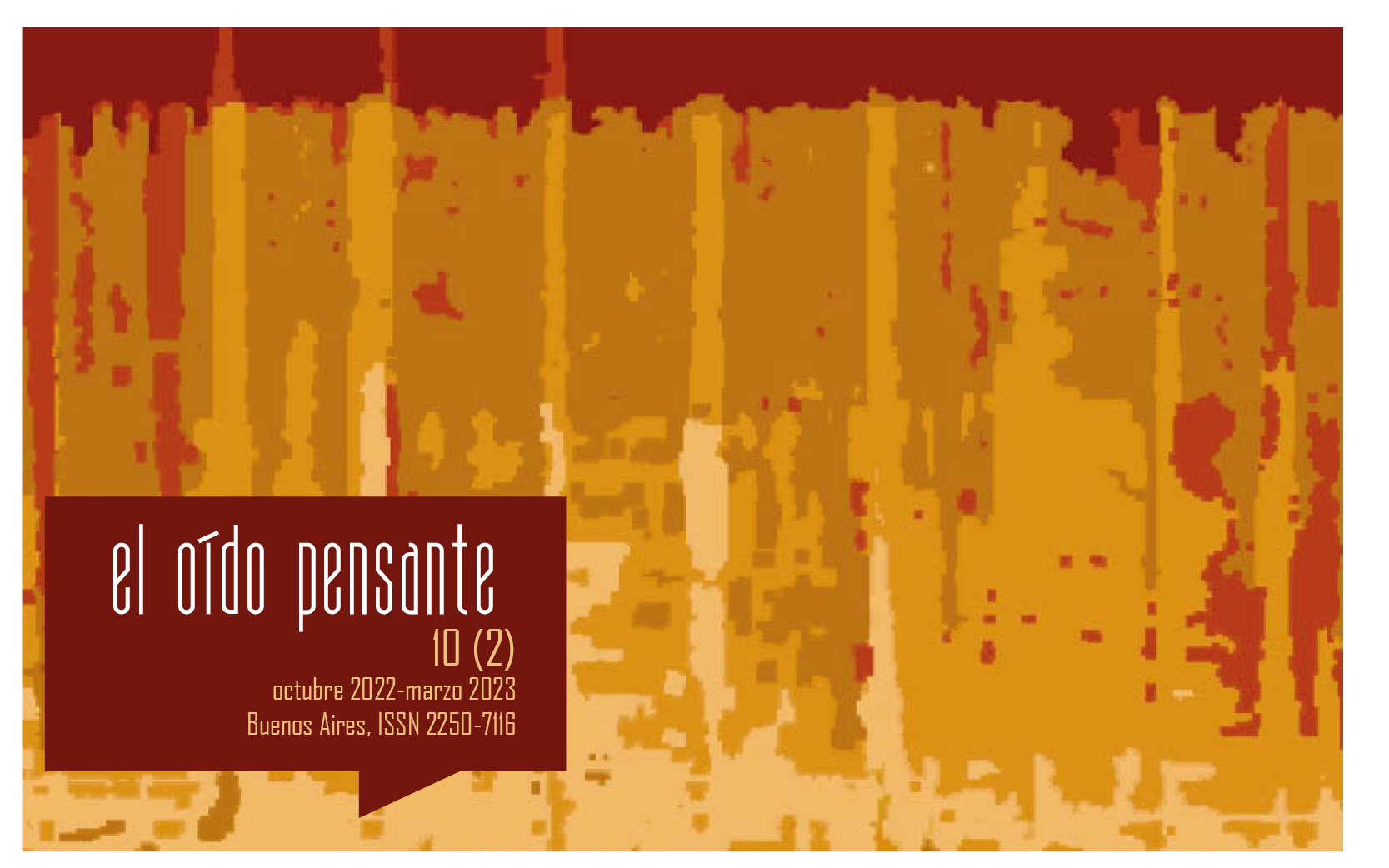The Blind Man’s Vision: Reflections on the Recurrence of the Blind Poet-Singer Archetype in Different Historical and Geographic Contexts
Abstract
The blind poet-singer corresponds to a recurrent figure in different moments of human history and in the most diverse regions of the globe. The present study presents a survey bringing together the varied ways in which this archetype manifested itself in space-time, demonstrating the existence of records of its presence in the 8th century BC, going through the successive periods in history, entering the 21st century. Its presence has manifested itself all over the world, in Asia, Europe, Africa and the Americas. Reflections on the blindness-music relationship are proposed, starting from the perspective of disability studies and neuroscientific research. In the final part, different meanings of the words "blindness" and "vision" are explored, which allow elucidating the complexity of the "vision of the blind", a fundamental concept for understanding the recurrence of the blind poet-singer archetype.Downloads
References
Albrecht, G. (Ed.). (2006). Encyclopedia of Disability. California: Sage Publications.
Arnaud, G. e Lecomt, H. (2006). Musiques de toutes les Afriques. Paris: Fayard.
Bloch, O. e von Wartburg, W. (2016). Dictionnaire étymologique de la langue française. Paris: Quadrige / Puf.
Bluteau, R. (1789). Diccionario da língua portuguesa composto pelo padre D. Rafael Bluteau. Lisboa: Na Officina de Simão Thaddeo Ferreira. Recuperado de https://archive.org/details/diccionariodalin00mora
Carnelos, L. (2016). Street Voices. The Role of Blind Performers in Early Modern Italy. Italian Studies, 71(2), 184-196. doi: 10.1080/00751634.2016.1175716
Cascudo, L. C. (2012). Dicionário do folclore brasileiro. São Paulo: Global.
Cascudo, L. C. (2009). Vaqueiros e cantadores. São Paulo: Global.
Ciccone, L. (2001). Les musiciens aveugles dans l’histoire. Paris: L’Harmattan.
Conway, C. (2003). Black Banjo Songsters in Appalachia. Black Music Research Journal, 23(1/2), 149-166. Recuperado de https://www.jstor.org/stable/3593213
De Ferranti, H. (2009). The Last Biwa Singer: A Blind Musicien in History, Imagination, and Performance. Nova York: Cornell East Asia Series.
Díaz, J. (1992). Coplas de ciegos: Antología de pliegos de cordel. Valladolid: Ámbito. Recuperado de http://www.cervantesvirtual.com/descargaPdf/coplas-de-ciegos-antologia/
Díez, Á. D. (2016). El ciego coplero violinista en Galicia y su revival a través del repertorio de Florencio dos Vilares (1914-1986). (tesis de grado). Universidad de Valladolid, Valladolid, España. Recuperado de https://uvadoc.uva.es/handle/10324/18485
Dutry, R. e Servais, G. (Eds.). (1996). Figures littéraires de la cécité du Moyen Age au XXe siècle. Voir, 12-13, 6-9.
Fauriel, C. (1824). Chants Populaire de la Grèce Moderne. Paris: Chez Firmin Didot, Père et Fils. Recuperado de https://gallica.bnf.fr/ark:/12148/bpt6k113943j.texteImage#
Figueiredo, C. (2010). Novo dicionário da língua portuguesa. Recuperado de https://www.gutenberg.org/files/31552/31552-pdf.pdf
Folqman, C. (1755). Diccionario portuguez, e latino. Lisboa: Officina de Miguel Menescal da Costa. Recuperado de http://purl.pt/12012
Govenar, A. (2000). Blind Lemon Jefferson: The Myth and the Man. Black Music Research Journal, 20(1), 7-21. Recuperado de https://www.jstor.org/stable/i231875
Henderson, I. (1969). Ancient Greek Music. En E. Wellesz (Ed.). New Oxford History of Music. Vol. I. London: Oxford University Press.
Hogan, B. (2011). Enemy Music: Blind Birifor Xylophonists of Northwest Ghana. (tesis de doctorado). University of California, Los Angeles, Estados Unidos.
Hogan, B. (2016). They Say We Exchanged Our Eyes for the Xylophone: Resisting Tropes of Disability as Spiritual Deviance in Birifor Music. En B. Howe, S. Jensen-Moulton, N. Lerner e J. Straus. The Oxford Handbook of Music and Disability Studies (pp. 112-130). New York: Oxford University Press.
Howe, B., Jensen-Moulton, S., Lerner, N. e Straus, J. (2016). Introduction: Disability Studies in Music, Music in Disability Studies. En The Oxford Handbook of Music and Disability Studies (pp. 1-11). New York: Oxford University Press.
Iglesias, A. (2016). El ciego callejero en la España Moderna: balance y propuestas. Labor Histórico, 2(1), 74-90. doi: https://doi.org/10.24206/lh.v2i1.4809
Jung, C. G. (2002). Os arquétipos e o inconsciente coletivo. Petrópolis: Vozes.
Kachulev, I. (1963). Gadulkas in Bulgaria. The Galpin Society Journal, 16, 95-107. Recuperado de https://www.jstor.org/stable/841098?refreqid=excelsior%3A891aef30a929f55c5adcfb450a92570e
Kangussu, I. (2004). Sobre eros no Fedro. En R. T. Souza e R. Duarte (Orgs.). Filosofia e literatura (pp. 21-33). Porto Alegre: EDIPUCRS.
Khê, T. V. (1966). La musique populaire au Vietnam. Ses attaches avec la musique de tradition savante ou la musique rituelle. Journal of the International Folk Music Council, 18, 2-14.
Kononenko, N. (1998). Ukranainian Minstrels: And the Blind Shall Sing. London: Routledge.
Landels, J. G. (2009). Music in Ancient Greece and Rome. London: Routledge.
Linemburg, J. (2017). Cegueira e rabeca: instrumentos de uma poética. Florianópolis: Quebra-ventos: modos de fazer.
Lubet, A. (2011). Music, Disability, and Society. Philadelphia: Temple University Press.
Lubet, A (2006). Music and Blindness. En G. L. Albrecht (Ed.). Encyclopedia of Disability. Vol. 3 (pp. 1123-1125). Thousand Oaks: Sage Publications.
Michaelis. (2015). Arquétipo. Dicionário Brasileiro da Língua Portuguesa. Melhoramentos. Recuperado de http://michaelis.uol.com.br/busca?r=0&f=0&t=0&palavra=arqu%C3%A9tipo
Morin, E. (2005). Introduction à la pensée complexe. Paris: Le Seuil.
Mota, L. (2002). Cantadores: poesia e linguagem do sertão cearense. Rio de Janeiro: ABC.
Nascentes, A. (1955). Dicionário etimológico da Língua Portuguêsa. Rio de Janeiro: Livraria Acadêmica. Recuperado de https://ia801200.us.archive.org/6/items/DICIONARIOETIMOLOGICORESUMIDODALINGUAPORTUGUESAANTENORNASCENTES/DICION%C3%81RIO%20ETIMOL%C3%93GICO%20RESUMIDO%20DA%20LINGUA%20PORTUGUESA%20%20ANTENOR%20NASCENTES.pdf
Oliveira, E. V. (1982). Instrumentos musicais populares portugueses. Lisboa: Fundação Calouste Gulbenkian.
OMS (2010). Global Data on Visual Impairments. Recuperado de https://icd.who.int/browse10/2016/en
Pasqualotto, A., Lam, J. S. Y. e Proulx, M. J. (2013). Congenital Blindness Improves Semantic and Episodic Memory. Behavioural Brain Research, 244, 162-165. Recuperado de https://pubmed.ncbi.nlm.nih.gov/23416237/
Pinto, L. M. S. (1832). Diccionario da Lingua Brasileira. Ouro Preto: Typographia de Silva. Recuperado de https://digital.bbm.usp.br/bitstream/bbm/5414/1/022541_COMPLETO.pdf
Poché, C. (2005). Dictionnaire des musiques et danses traditionnelles de la Méditerranée. Paris: Fayard.
Raffa, M. (2005). Music and the Muses: The Culture of ‘Mousike’ in the Classical Athenian City edited by Penelope Murray and Peter Wilson. Aestimatio, 2, 108-118. Recuperado de https://www.degruyter.com/document/doi/10.31826/9781463222468-020/pdf
Rauschecker, J. P. (2001). Cortical Plasticity and Music. Annals of the New York Academy of Sciences, 930, 330-336. Recuperado de https://pubmed.ncbi.nlm.nih.gov/11458839/
Raz, N., Striem, E., Pundak, G., Orlov, T. e Zohary, E. (2007). Superior Serial Memory in the Blind: A Case of Cognitive Compensatory Adjustment. Current Biology, 17(3), 1129-1133. Recuperado de https://pubmed.ncbi.nlm.nih.gov/17583507/
Ribeiro, D. A. (1992). Cantigas de cego. João Pessoa: s/e.
Rivas, X. L. e Iglesias, B. (2000). Cantos, coplas e romances de cego. 2 vols. Lugo: Ophiusa.
Sacks, O. (2007). An Auditory World: Music and Blindness. En O. Sacks. Musicophilia: Tales of Music and the Brain (pp. 160-164). New York: Alfred A. Knopf.
Sadie, S. (1984). The New Grove Dictionary of Musical Instruments. 3 vols. Londres: Macmillan Press Limited.
Samson, J. (2013). Music in the Balkans. Leiden: Brill.
Santo Agostinho (2013). De genesi ad litteram, 354-430, trad. de Correia, M. e Silva, P. O., Agostinho de Hipona - Comentário literal ao Livro do Genesis (em doze livros): Livro XII, Civitas Avgvstiniana, 3, Porto: Instituto de Filosofia da Universidade de Porto, 121-164. Recuperado de https://ojs.letras.up.pt/index.php/civaug/article/view/648
Sardegna, J., Shelly, S., Rutzen, A. R. e Steidl, S. M. (2002). The Encyclopedia of Blindness and Visual Impairment. 2a ed. New Tork: Facts on File.
Sardinha, J. A. (2000). Tradições musicais da Estremadura. Vila Verde: Tradisom.
Schlapbach, K. (2006). Intellectual Vision in Augustine, De Genesi ad litteram 12 or: Seeing the Hidden Meaning of Images. Studia Patristica, 39, 239-244.
Schubart, D., Santamarina, A., Vavrinecz, A. e Pinheiro, R. (2015). Florencio, cego dos Vilares. Fonsagrada: A Central Folque.
Silverman, J. S. (2011). Seeing While Blind: Disability, Theories of Vision, And Milton’s Poetry. (tesis de doctorado). Florida State University, Tallahassee, Estados Unidos. Recuperado de https://diginole.lib.fsu.edu/islandora/object/fsu:176219/datastream/PDF/view
Straus, J. N. (2011). Extraordinary Measures: Disability in Music. Oxford: Oxford University Press.
West, M. L. (2007). Indo-European Poetry and Myth. Oxford: Oxford University Press.
Zumthor, P. (1983). Introduction à la poésie orale. Paris: Éditions du Seuil.
Zumthor, P. (1993) A Letra e a voz: a “literatura” medieval. São Paulo: Companhia das Letras.
Discografia
Quaresma, T. (1975). Nordeste: cordel, repente e canção. Tapecar.























